
Concept Introduction:
Requirement 1a:
To calculate:
The amount of sales on account for Pelkey Co. for the year ended December 31, 2016.
Concept Introduction:
Cash flows to accrual: The method of cash flow under which the revenues and expenses are recorded but cash and cash equivalents are not received or paid or exchanged refers to cash flow to accrual. Accrued revenues and expenses does not impact the cash flow until the cash is received or paid.
Requirement 1b:
To calculate:
The amount of income tax expense of Pelkey Co. for the year end December 31, 2016.
Concept Introduction:
Cash flows to accrual: The method of cash flow under which the revenues and expenses are recorded but cash and cash equivalents are not received or paid or exchanged refers to cash flow to accrual. Accrued revenues and expenses does not impact the cash flow until the cash is received or paid.
Requirement 1c:
To calculate:
The amount of cost of goods sold for Pelkey Co. for the year ended December 31, 2016.
Concept Introduction:
Cash flows to accrual: The method of cash flow under which the revenues and expenses are recorded but cash and cash equivalents are not received or paid or exchanged refers to cash flow to accrual. Accrued revenues and expenses does not impact the cash flow until the cash is received or paid.
Requirement 1d:
To calculate:
The amount of
Want to see the full answer?
Check out a sample textbook solution
Chapter 9 Solutions
Accounting: What the Numbers Mean
- Computing Return on Assets and Applying the Accounting Equation Nordstrom Inc. reports net income of $564 million for a recent fiscal year. At the beginning of that fiscal year, Nordstrom had $8,115 million in total assets. By fiscal year end, total assets had decreased to $7,886 million. What is Nordstrom’s ROA? Note: Enter answer as a percentage rounded to the nearest 2 decimal places (ex: 24.58%). ROA Answerarrow_forwardComputing and Interpreting Financial Statement RatiosFollowing are selected ratios of Norfolk Southern. Return on Assets (ROA) Component FY4 FY3 Profitability (Net income/Sales) 25.7% 27.0% Productivity (Sales/Average assets) 0.329 0.291 a. Was the company profitable in FY4? Answer 1b. In which year was the company more profitable? Answer 2c. Is the change in productivity a positive or negative development? Answer 3d. Compute the company’s ROA for both years. Note: Enter your answer as a percentage rounded to one decimal place (Ex: 29.4%).FY4 Answer 4%FY3 Answer 5%e. From the information, which of the following best explains the change in ROA during FY4?arrow_forwardExpand upon it and add to itarrow_forward
- Define these terms: A) Information Asymmetry. B) Material misstatement in the audited financial statements. C) The term "Professional Skepticism." D) Contribution margin ratio. E) Gross Margin, also known as Gross Profit Margin.arrow_forwardNo Ai Which of the following errors will cause the trial balance to not balance?A. Omission of a transactionB. Entry posted twiceC. Transposing digits in one sideD. Debiting one account and crediting anotherarrow_forwardDon't use ChatGPT!! Which of the following errors will cause the trial balance to not balance?A. Omission of a transactionB. Entry posted twiceC. Transposing digits in one sideD. Debiting one account and crediting anotherarrow_forward
- Which of the following is a temporary account?A. Retained EarningsB. Service RevenueC. Accounts PayableD. Inventoryarrow_forwardWhich of the following errors will cause the trial balance to not balance?A. Omission of a transactionB. Entry posted twiceC. Transposing digits in one sideD. Debiting one account and crediting anotherarrow_forwardMime Delivery Service is owned and operated by Pamela Kolp. The following selected transactionswere completed by Mime Delivery Service during October:1. Received cash from the owner as an additional investment, $7,500.2. Paid creditors on account, $815.3. Billed customers for delivery services on account, $3,250.4. Received cash from customers on account, $1,150.5. Paid cash to the owner for personal use, $500.Required:Indicate the effect of each transaction on the accounting equation elements (Assets, Liabilities,Owner’s Equity, Drawing, Revenue, and Expense) by listing the numbers identifying the transactions,(1) to (5). Also, indicate the specific item within the accounting equation element that is affected, i.e.(1) Asset (Cash) increases by $; Owner’s Equity (Pamela Kolp, Capital) increases by $.arrow_forward
- When a company incurs an expense but does not yet pay it, what is the entry?A. Debit Expense, Credit CashB. Debit Liability, Credit ExpenseC. Debit Expense, Credit LiabilityD. No entry needed helparrow_forwardWhen a company incurs an expense but does not yet pay it, what is the entry?A. Debit Expense, Credit CashB. Debit Liability, Credit ExpenseC. Debit Expense, Credit LiabilityD. No entry neededarrow_forwardDont use ai What is the effect of writing off an uncollectible account under the allowance method?A. Increases net incomeB. No effect on total assetsC. Decreases revenueD. Increases expensesarrow_forward

 AccountingAccountingISBN:9781337272094Author:WARREN, Carl S., Reeve, James M., Duchac, Jonathan E.Publisher:Cengage Learning,
AccountingAccountingISBN:9781337272094Author:WARREN, Carl S., Reeve, James M., Duchac, Jonathan E.Publisher:Cengage Learning, Accounting Information SystemsAccountingISBN:9781337619202Author:Hall, James A.Publisher:Cengage Learning,
Accounting Information SystemsAccountingISBN:9781337619202Author:Hall, James A.Publisher:Cengage Learning, Horngren's Cost Accounting: A Managerial Emphasis...AccountingISBN:9780134475585Author:Srikant M. Datar, Madhav V. RajanPublisher:PEARSON
Horngren's Cost Accounting: A Managerial Emphasis...AccountingISBN:9780134475585Author:Srikant M. Datar, Madhav V. RajanPublisher:PEARSON Intermediate AccountingAccountingISBN:9781259722660Author:J. David Spiceland, Mark W. Nelson, Wayne M ThomasPublisher:McGraw-Hill Education
Intermediate AccountingAccountingISBN:9781259722660Author:J. David Spiceland, Mark W. Nelson, Wayne M ThomasPublisher:McGraw-Hill Education Financial and Managerial AccountingAccountingISBN:9781259726705Author:John J Wild, Ken W. Shaw, Barbara Chiappetta Fundamental Accounting PrinciplesPublisher:McGraw-Hill Education
Financial and Managerial AccountingAccountingISBN:9781259726705Author:John J Wild, Ken W. Shaw, Barbara Chiappetta Fundamental Accounting PrinciplesPublisher:McGraw-Hill Education





